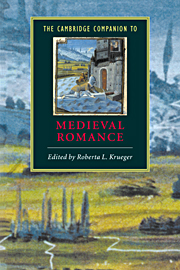Book contents
- Frontmatter
- Introduction
- Part 1 The origins, forms, and contexts of medieval romance
- Part 2 European romance and medieval society
- 5 Courts, clerks, and courtly love
- 6 The societal role of chivalry in romance
- 7 The other worlds of romance
- 8 Questions of gender in Old French courtly romance
- 9 Women and men in late medieval English romance
- Part 3 European transformations
- Editions and translations
- Index
- Series list
5 - Courts, clerks, and courtly love
from Part 2 - European romance and medieval society
Published online by Cambridge University Press: 28 May 2006
- Frontmatter
- Introduction
- Part 1 The origins, forms, and contexts of medieval romance
- Part 2 European romance and medieval society
- 5 Courts, clerks, and courtly love
- 6 The societal role of chivalry in romance
- 7 The other worlds of romance
- 8 Questions of gender in Old French courtly romance
- 9 Women and men in late medieval English romance
- Part 3 European transformations
- Editions and translations
- Index
- Series list
Summary
The term “courtly love” was coined in 1883 by Gaston Paris with reference to Le Chevalier de la Charrete (also known as the Lancelot) by Chrétien de Troyes, the earliest surviving narrative of the adulterous love between Arthur’s knight Lancelot and his Queen Guenevere. This romance, with its disquieting combination of illicit sex and quasi-mystical love, has remained ever since in the forefront of discussions of what “courtly love” might be. The resulting drawback of these discussions, in my view, has been their assumption that such love was susceptible of codification as a system of rules or doctrines. This essay will seek to locate “courtly love” more broadly as a series of questions which are debated across large numbers of texts, and which can be traced back to the tensions within medieval court life. These tensions are responded to very differently by Chrétien’s immediate precursors, the Eneas seeking to contain them within safe limits while the Tristan romances give rein to their potential disruptiveness. Within the two poles represented by these two influential stories, Chrétien himself explores various ways of negotiating the pressures of medieval court life. His Lancelot is the most famous, but by no means definitive, outcome of these explorations.
- Type
- Chapter
- Information
- The Cambridge Companion to Medieval Romance , pp. 81 - 96Publisher: Cambridge University PressPrint publication year: 2000
- 3
- Cited by

